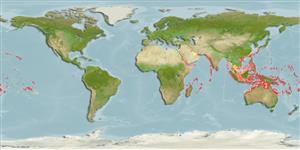Common names from other countries
Classification / Names
आम नाम | उपशब्द | Catalog of Fishes(वर्ग, प्रजाति) | ITIS | CoL | WoRMS | Cloffa
>
Acanthuriformes (Surgeonfishes) >
Acanthuridae (Surgeonfishes, tangs, unicornfishes) > Acanthurinae
Etymology: Zebrasoma: Derived from Zebra = African horse + Greek, soma = body; referring to the stripes (Ref. 45335).
More on author: Bloch.
Environment: milieu / climate zone / depth range / distribution range
पारिस्थितिकी
समुद्री प्रवाल-भित्ति संयुक्त; गहराई सीमा 0 - 45 m (Ref. 90102), usually 2 - 30 m (Ref. 27115). Tropical; 24°C - 28°C (Ref. 27115); 36°N - 25°S, 33°E - 134°W
Eastern Indian Ocean to the Pacific Ocean: Christmas Island and most of the East Indian region to South China Sea, Hawaii and Pitcairn Islands; north to Japan and Ogasawara Islands; south to western and eastern Australia; Replaced by Zebrasoma desjardinii in the Indian Ocean.
आकार / वज़न / Age
Maturity: Lm ? range ? - ? cm
Max length : 40.0 cm SL पुल्लिंग / अलिंग; (Ref. 9710)
पृष्ठीय रीढ़ (सम्पूर्ण): 4 - 5; पृष्ठीय सौफट रेज़ (सम्पूर्ण): 29-33; गुदा कांटा 3; ऐनल सौफट रेज़: 23 - 26. Smalls juveniles have alternating yellow and black bars. No brush-like patch of setae posteriorly on side of body. Dorsal fin very elevated, the longest ray 2.1 to 2.5 times in SL (Ref 9808).
Benthopelagic (Ref. 58302). Occurs in lagoon and seaward reefs from the lower surge zone to a depth of at least 30 m. Solitary juveniles found among rocks or coral (Ref. 58534) of shallow protected, sometimes turbid reefs (Ref. 1602, 48637). Feeds on leafy macroalgae. It possesses, fewer and larger pharyngeal teeth, compared to the other Zebrasoma spp. (Ref. 33204). Diurnal species (Ref. 113699:32); courtship and spawning takes place from morning to afternoon and is often confined to ebb tides (Ref. 38697). The species is never poisonous (Ref. 4795). Minimum depth reported taken from Ref. 128797.
Life cycle and mating behavior
परिपक्व अवधि | पुनरुत्पत्ति | मछलीऔ का अंडे देना | अंडे | Fecundity | लार्वा
Paired spawning (Ref. 240).
Myers, R.F., 1999. Micronesian reef fishes: a comprehensive guide to the coral reef fishes of Micronesia, 3rd revised and expanded edition. Coral Graphics, Barrigada, Guam. 330 p. (Ref. 37816)
IUCN Red List Status (Ref. 130435)
CITES (Ref. 128078)
Not Evaluated
Threat to humans
Harmless
Human uses
मात्स्यिकी: लघु वाणिज्य; जलजीवालय: व्यापारिक
अधिक जानकारी
संदर्भजलीयकृषिजलीयकृषि रूपरेखाखींचआनुवंशिकीElectrophoresesहैरेटिबिलटीबीमारीप्रक्रमणMass conversion
साधन
Special reports
Download XML
इंटरनेट स्रोत
Estimates based on models
Preferred temperature (Ref.
115969): 24.8 - 28.9, mean 27.6 (based on 874 cells).
Phylogenetic diversity index (Ref.
82804): PD
50 = 0.5078 [Uniqueness, from 0.5 = low to 2.0 = high].
Bayesian length-weight: a=0.02399 (0.01460 - 0.03941), b=2.93 (2.79 - 3.07), in cm Total Length, based on LWR estimates for this species & (Sub)family-body (Ref.
93245).
Trophic level (Ref.
69278): 2.0 ±0.00 se; based on food items.
लौटाव (Ref.
120179): माध्यम, न्यूनतम जनसंख्या दुगनी होने का समय 1.4 - 4.4 वर्ष। (K=0.282; Tmax=27).
Fishing Vulnerability (Ref.
59153): Moderate vulnerability (37 of 100).
